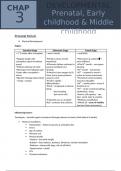CHAP DEVELOPMENTAL
3
TER
Prenatal, Early
PSYCHOLOGY
childhood & Middle
Prenatal Period
childhood
Physical Development
Stages:
Germinal Stage Embryonic Stage Foetal Stage
= 1st 2 weeks after conception. = next 6 weeks. = until birth.
Zygote (single cell) – Embryo (mass of cells Structures & systems +
conception (sperm fertalised implanted). more efficient.
ovum). Placenta (allows nutrients to 3rd/4th month – sex organs
Mitosis (division of cells) pass) & Umbilical cord develop.
Emerges from fallopian tube develop. 4th month – movement.
(4 days after conception) – Arteries (carry oxygen to) & 5th – respond to sound +
uterus Veins (carry waste products orient to moms movements.
genetic heritage determined away) in cord> Cerebral cortex (complex,
– merge = unique Cells x rapidly – conscious thought).
differentiation. 6th – eyelids open + move &
End = recognized as Human breathe & cry.
being 7th – brain control breathing,
- Heart beating swallowing + temp.
- Spin nerve cells nerve cell capacity – see,
hear, smell, taste & vocalize.
Amniotic sac w/ amniotic Reflexes established.
fluid – protects and cushions. Week 26 = zone of viability
(survive if born premature).
Influencing factors:
Teratogens – harmful agents transferred through placenta to foetus (birth defects & death).
Maternal Conditions
Malnutrition – linked to poverty & unhealthy diet.
Stress
Age of mother
Planned/ not
Physical health
-Malaria = low birth weight
-Rubella = heart defects, deafness, blindness, mental retardation
-Diabetes = abnormally large, risk of still birth.
-Hypertension = death
STIs
Chemical substance
, -Alcohol = FAS (small heads, underdeveloped brains, short, mentally retarded)
-Tobacco = premature, miscarriage, stillbirth
-Prescription Drugs = many not safe
-Drugs = Weed (low weight + premature), Ecstasy (poor motor development)
Neonatal Period
Neonate = baby
= 1st 2-4 weeks post birth.
Infants – 20 reflexes (involuntary)
Rooting, sucking, swallowing etc.
Absence = early sign of neurological problems.
Perceptual Development
Vision Hearing Taste & Smell
Present @ birth Prefer mother’s voice Well-developed.
Blurred Distinguish Prefer sweet.
Not fully developed (eye Fascinated by baby talk
& visual cortex)
Prefer faces
Social & Emotional Development
Temperament
individual’s characteristic manner of responding to the environment.
1. Easy Temp – generally happy, adaptable, regular & easy to soothe.
2. Difficult temp – adapt slowly, distracted easily, inflexible, intense reactions, cry
frequently.
3. Slow-to-warm-up – adjust slowly, reactions not intense.
Bonding (Infants & Caregivers)
Natural process of mother falling in love w/baby after birth.
= Foundation for all development
Some abuse, neglect, abandon/ murder.
Obstacles:
Infants appearance – ‘ babyness’ evokes caregiving responses; impaired offspring do
not evoke positive caregiving behaviours (STUDIED IN ANIMALS). Baby smell & skin
texture evoke tenderness.
Mom’s Social & economic conditions – only care for child most likely to survive; don’t
bond with infant (Survival strategy) eg. Poverty.
(DEBATE) must occur in sensitive period -imprint immediately after birth.
, Preschool Period
PHYSICAL DEVELOPMENT BASIC TRENDS:
INFANCY - 1st 2 yrs = Rapid growth (Grow in spurts) Cephalocaudal developmental trend –
- Gain control over muscles head downward.
Head – Neck – Arms – Abdomen – Legs Proximodistal development trend –
- 4 – 6 months = weight doubled. centre downward.
- End of 1st yr = weight tripled.
- 1st 6 months = best nutrition ONLY breastmilk.
- Sleep 16 hrs = small naps – take break from so sounds textures etc (they don’t tune out
stimuli)
- 8-18 months – start walking (by 2 not – developmental issue)
2 – 6 yrs = slow growth (Childhood)
- Proportions change Gross motor skills – large
2yrs = head ¼ of body body movements (crawling
5½yrs = head 1/6 of body &running).
- Develop left/right handed (preference @ 2)
Fine motor skills – small
Brain & nervous system develop increasingly dense neural body movements (reaching
networks. & grasping, writing).
Ability to require new info > (influenced by
environment/genetics).
Physical activity = crucial for development (gross & fine motor skills)
Gross faster > Fine motor
Malnutrition – stunts growth, activity levels + learning and maturing delays.
COGNITIVE DEVELOPMENT (pre & neo)
1st 2 yrs = basic understanding (recognise objects + people, search for objects, understand
cause & effect relationships)
Assimilation – incorporating new
st
Piaget’s stages (1 2) experiences into existing schemas.
-construct own knowledge by building schemas (responses to
Accommodation – altering
certain stimuli) through Ass & Acc.
existing schemas to adapt to new
-Does not occur instantly – repeated no. of times
info.
Sensorimotor stage Preoperational stage
=Birth – 2yrs =2yrs – 7yrs
Gain knowledge of environment Use symbolic thought (language,
Ability to coordinate sensory input scribbles, gestures)
w/motor activity. No logical thinking yet.




